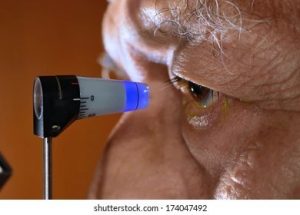Introduction:
Intra-ocular pressure (IOP) is the tissue pressure of the intraocular contents that is regulated by variations in the volume of the aqueous humour. It is a critical parameter for detecting and treating glaucoma. Normal IOP is in range of 10-21mmHg.
IOP depends upon various physiological factors which includes:
- Genetics
- Environmental factors
- Diurnal variation
- Intraocular conditions
- Postural variation
- Refractive errors
- Ethnicity
Diurnal variation test is an investigation, to measure IOP at various times of day and compare the results. It is done because, like other bodily irregularities, IOP varies throughout the day. It is often at its peak in the morning.The instrument used to measure IOP is named as TONOMETER. There are various types of TONOMETERS:
- Non contact Tonometer
- Contact Tonometer
- Digital Tonometer
- NON-CONTACT TONOMETER:
A non-contact tonometer measures ocular pressure with a little puff of air. The non-contact tonometer applanates the cornea using an air jet, avoiding direct contact between the instrument and the eye’s surface.
- CONTACT TONOMETER:
It includes:
- Indentation Tonometer; eg: Schiotz
- Applanation Tonometer; eg: Goldmann Applanation Tonometer
- Pneumatic Tonometer
- Perkins Tonometer
- Tono-pen
SCHIOTZ TONOMETER:
 The Schiotz tonometer operates on the indentation principle, which states that greater IOP takes more weight or force to indent.
The Schiotz tonometer operates on the indentation principle, which states that greater IOP takes more weight or force to indent.
It quantifies the depth of corneal indentation using a plunger with a known weight.
APPLANATION TONOMETER:
 It operates on the Imbert Fick Law concept, which says that the pressure within an ideal sphere is equal to the force required to flatten its surface divided by the area of flattening.
It operates on the Imbert Fick Law concept, which says that the pressure within an ideal sphere is equal to the force required to flatten its surface divided by the area of flattening.
PERKINS TONOMETER:
It is similar to Goldmann applanation Tonometer, the main difference is that it is handheld and portable.
PNEUMATIC TONOMETER:
It is electronic pressure sensing device that consists of glass filled chamber filled with silastic diaphragm.
TONOPEN:
It is electron sensing device that contains strain gauge and produces electrical signals as tip applanates the cornea.
DIGITAL TONOMETER:
It is also known as palpation or finger tension. It is the method of estimating intraocular pressure by gently pressing the index finger against the cornea of a closed eye
Importance:
Normal intraocular pressure helps supports the shape of the eye. If the IOP remains high (between 15 and 25 mmHG) for a long stretch of time without medication, the pressure will constantly push on the optic nerve, causing damage and, as a result, irreversible vision loss. In rare situations, the IOP rises abruptly, exceeding 30 mm HG or even approaching 40 mm HG. This is typically caused by angle-closure glaucoma or eye trauma, and it can result in serious optic nerve damage with little warning.
Conclusion:
Single higher IOP measurements may not be an abnormality or be related to compliance, but they may identify individuals who are at high risk of developing glaucoma and should thus be watched more closely and maybe treated more aggressively. The earlier the diagnosis of the condition, the better the chances of averting vision loss and/or retaining residual eyesight.
The Optometry department of Sushant University, one of the top universities in Delhi-NCR, has all the instruments available in its Vision Clinic for practical training of the students as it is an extremely important topic.
Bhavya Marwaha, B.Optom Student; Roshni Sengupta, Assistant Professor; SHS, Sushant University
